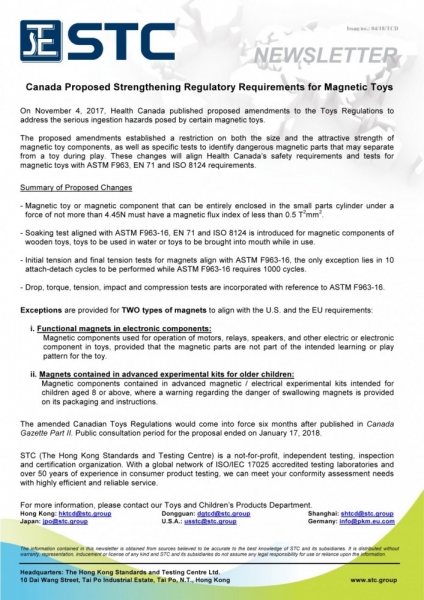
Canada Proposed Strengthening Regulatory Requirements for Magnetic Toys
On November 4, 2017, Health Canada published proposed amendments to the Toys Regulations to address the serious ingestion hazards posed by certain magnetic toys. The proposed amendments established a restriction on both the size and the attractive strength of magnetic toy components, as well as specific tests to identify dangerous magnetic parts that may separate from a toy during play. These changes will align Health Canada’s safety requirements and tests for magnetic toys with ASTM F963, EN 71 and ISO 8124 requirements. Summary of Proposed Changes - Magnetic toy or magnetic component that can be entirely enclosed in the small parts cylinder under a force of not more than 4.45N must have a magnetic flux index of less than 0.5 T2mm2. - Soaking test aligned with ASTM F963-16, EN 71 and ISO 8124 is introduced for magnetic components of wooden toys, toys to be used in water or toys to be brought into mouth while in use. - Initial tension and final tension tests for magnets align with ASTM F963-16, the only exception lies in 10 attach-detach cycles to be performed while ASTM F963-16 requires 1000 cycles. - Drop, torque, tension, impact and compression tests are incorporated with reference to ASTM F963-16. Exceptions are provided for TWO types of magnets to align with the U.S. and the EU requirements: i. Functional magnets in electronic components: Magnetic components used for operation of motors, relays, speakers, and other electric or electronic component in toys, provided that the magnetic parts are not part of the intended learning or play pattern for the toy. ii. Magnets contained in advanced experimental kits for older children: Magnetic components contained in advanced magnetic / electrical experimental kits intended for children aged 8 or above, where a warning regarding the danger of swallowing magnets is provided on its packaging and instructions. The amended Canadian Toys Regulations would come into force six months after published in Canada Gazette Part II. Public consultation period for the proposal ended on January 17, 2018.
[See PDF version for more information]










